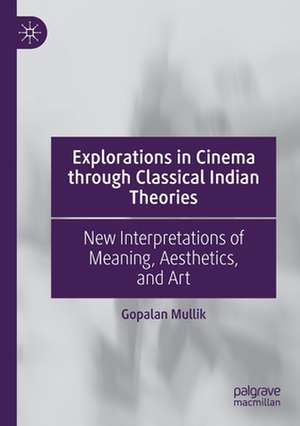Explorations in Cinema through Classical Indian Theories: New Interpretations of Meaning, Aesthetics, and Art
Autor Gopalan Mulliken Limba Engleză Paperback – 27 iun 2021
| Toate formatele și edițiile | Preț | Express |
|---|---|---|
| Paperback (1) | 697.65 lei 6-8 săpt. | |
| Springer International Publishing – 27 iun 2021 | 697.65 lei 6-8 săpt. | |
| Hardback (1) | 708.61 lei 6-8 săpt. | |
| Springer International Publishing – 27 iun 2020 | 708.61 lei 6-8 săpt. |
Preț: 697.65 lei
Preț vechi: 820.76 lei
-15% Nou
Puncte Express: 1046
Preț estimativ în valută:
133.49€ • 139.39$ • 110.23£
133.49€ • 139.39$ • 110.23£
Carte tipărită la comandă
Livrare economică 15-29 aprilie
Preluare comenzi: 021 569.72.76
Specificații
ISBN-13: 9783030456139
ISBN-10: 3030456137
Pagini: 351
Ilustrații: XV, 351 p. 41 illus., 12 illus. in color.
Dimensiuni: 148 x 210 mm
Greutate: 0.44 kg
Ediția:1st ed. 2020
Editura: Springer International Publishing
Colecția Palgrave Macmillan
Locul publicării:Cham, Switzerland
ISBN-10: 3030456137
Pagini: 351
Ilustrații: XV, 351 p. 41 illus., 12 illus. in color.
Dimensiuni: 148 x 210 mm
Greutate: 0.44 kg
Ediția:1st ed. 2020
Editura: Springer International Publishing
Colecția Palgrave Macmillan
Locul publicării:Cham, Switzerland
Cuprins
1. Introduction.- 2. Film Theories and Cinema: Limitations of Disembodied Vision in Existing Film Discourse.- 3. Vedic Cosmology and the Notion of Correlative Opposites: A Classical Indian Paradigm of Thought and Its Influence on Artworks.- 4. Nyāya Theory of Perception or Pratyakṣa: An Embodied Theory of “Meaning” and Its Relation to Cinema.- 5. Bharata’s Theory of Rasa or Aesthetic Pleasure: Classical Indian Theories of “Aesthetics” and Their Relation to Cinema.- 6. Ānandavardhana’s Theory of Suggestion or Dhvani: Classical Indian Theories of “Art” and Their Relation to Cinema.- 7. Conclusion
Notă biografică
Dr. Gopalan Mullik is a Visiting Lecturer at St. Xavier's University, Kolkata, India.
Textul de pe ultima copertă
"This book is a cutting-edge treatise that propels contemporary film theory into untrodden territory. It revolutionarily disentangles film theory from Eurocentric fixations to radically re-think the nature of moving images by adroitly summoning robust theories of Indian epistemological traditions. Mullik dexterously employs Indian theories of perception (Nyāya), aesthetics (Bharata), and suggestion (Ānandavardhana) to comprehend meaning-making in cinematic modernity. This project is an indisputably original study that encompasses exceptionally complex integration of pre-modern Indian philosophical formulations with contemporary film theory."
--Ashish Avikunthak, Filmmaker and Associate professor, University of Rhode Island, USA
For the first time, this book applies the wisdom of classical Indian theories to read cinema. Gopalan Mullik contends that existing Euro-centric film theories are moribund because of their interest in making prescriptive claims regarding how cinema should be viewed, rather than attending to how films are actually experienced by ordinary audiences. Classical Indian (or “Hindu”) theories offer a theory of the ordinary which helps to project perceptual, aesthetic, and artistic responses of average filmgoers to cinema. After indicating the limitations of existing film theories, this book then discusses the Vedic cosmological principles that form the foundation of three “Hindu” theories: the Nyāya theory of perception or pratyakṣa, Bharata’s theory of aesthetic pleasure or rasa, and Ānandavardhana’s theory of artistic suggestion or dhvani, all of which provide striking insights into our understanding of cinema. By applying these theories to analyses of both Indian and Western films, Mullik demonstrates that, despite their Indian origin, they possess a universal validity. A unique feature of the work is its observation of certain extraordinary similarities between classical Indian thought and modern Western thinking involving structuralism, post-structuralism, post-modernism, and embodied aspects of phenomenology that have important consequences for understanding cinema. Dr. Gopalan Mullik is a Visiting Lecturer at St. Xavier’s University, Kolkata, India.
For the first time, this book applies the wisdom of classical Indian theories to read cinema. Gopalan Mullik contends that existing Euro-centric film theories are moribund because of their interest in making prescriptive claims regarding how cinema should be viewed, rather than attending to how films are actually experienced by ordinary audiences. Classical Indian (or “Hindu”) theories offer a theory of the ordinary which helps to project perceptual, aesthetic, and artistic responses of average filmgoers to cinema. After indicating the limitations of existing film theories, this book then discusses the Vedic cosmological principles that form the foundation of three “Hindu” theories: the Nyāya theory of perception or pratyakṣa, Bharata’s theory of aesthetic pleasure or rasa, and Ānandavardhana’s theory of artistic suggestion or dhvani, all of which provide striking insights into our understanding of cinema. By applying these theories to analyses of both Indian and Western films, Mullik demonstrates that, despite their Indian origin, they possess a universal validity. A unique feature of the work is its observation of certain extraordinary similarities between classical Indian thought and modern Western thinking involving structuralism, post-structuralism, post-modernism, and embodied aspects of phenomenology that have important consequences for understanding cinema. Dr. Gopalan Mullik is a Visiting Lecturer at St. Xavier’s University, Kolkata, India.
Caracteristici
The first book of its kind to apply traditional Indian theories to cinema as a means of examining film Compares and contrasts Indian theories with Western approaches to open film theory to exciting new avenues while still acknowledging existing works Includes illustrations, boxes, and figures to help convey dense theoretical concepts
